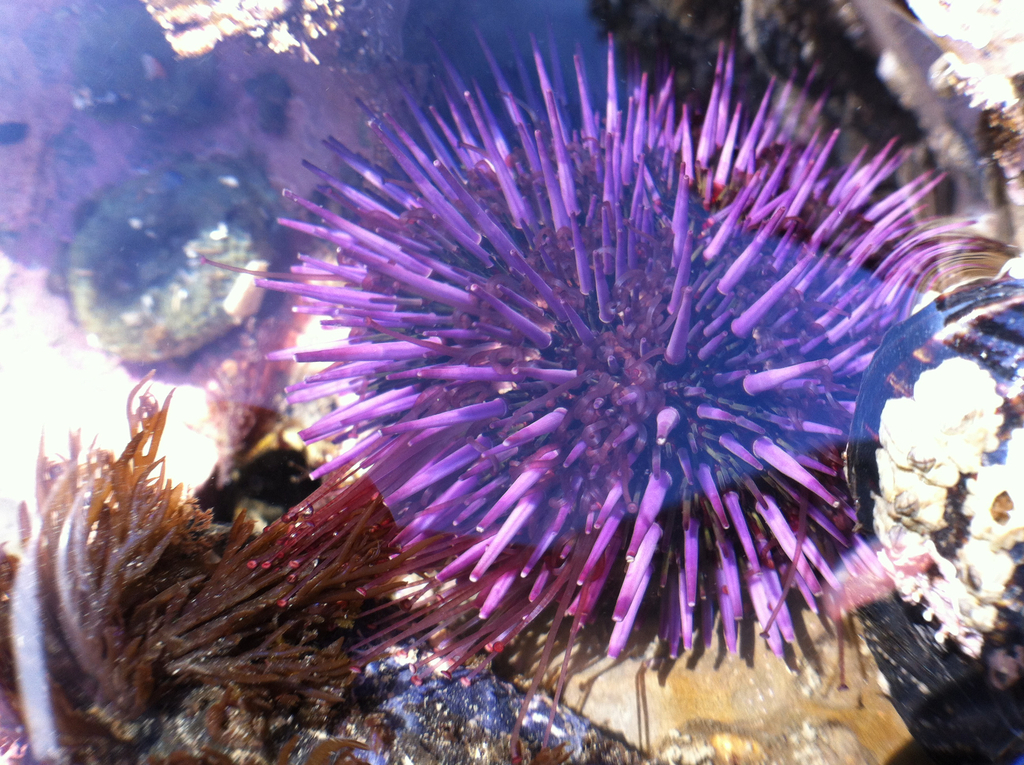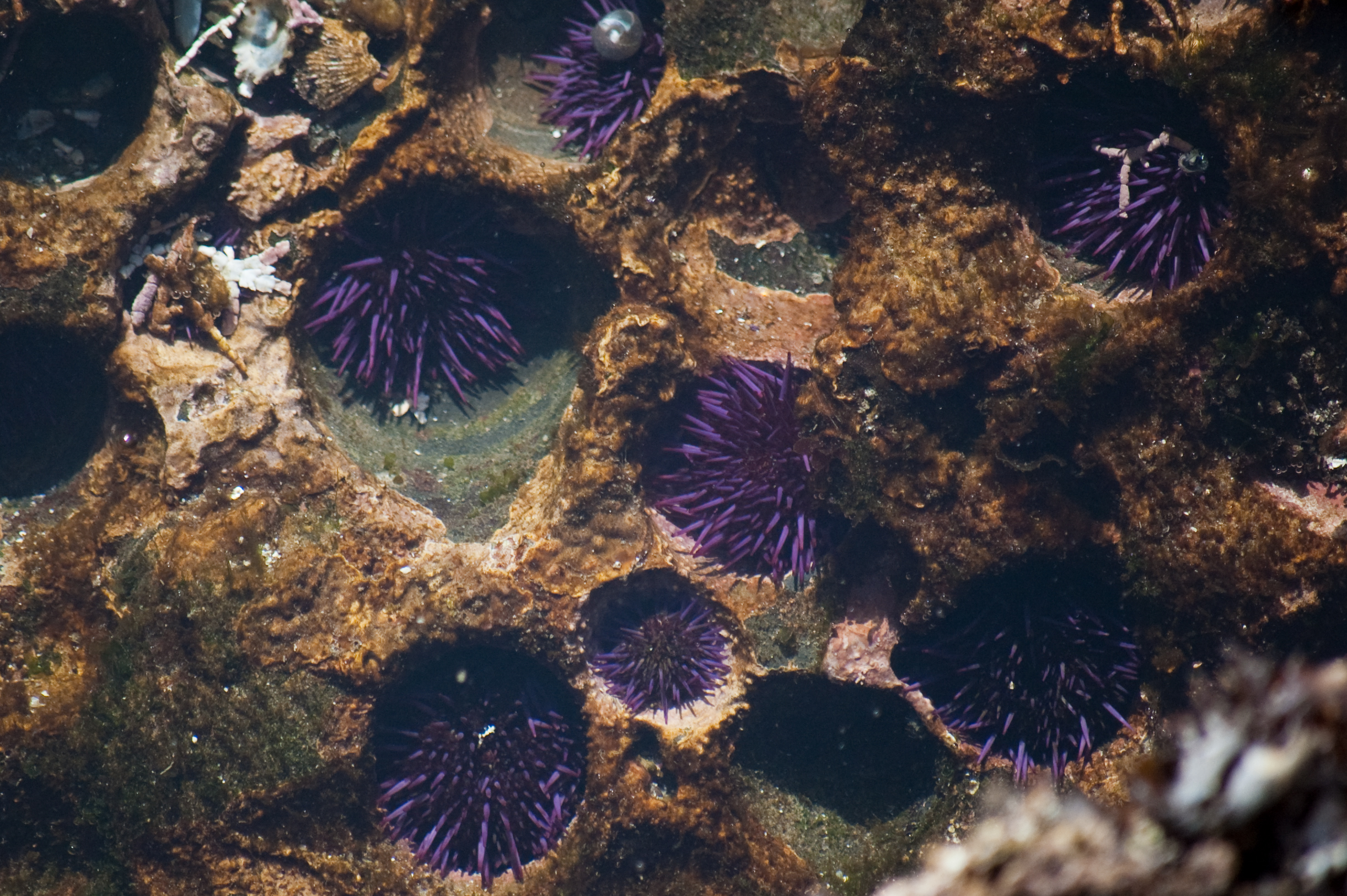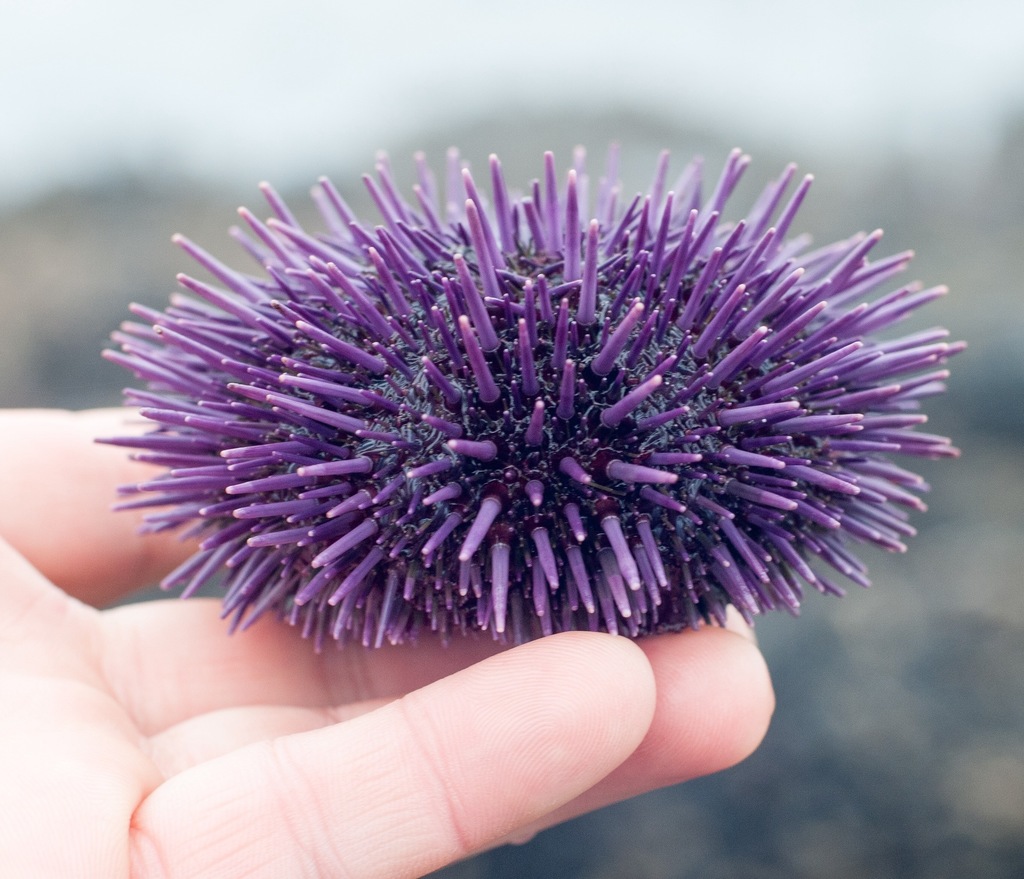Strongylocentrotus purpuratus
North Coast (Oregon Border to Point Arena)
North Central Coast (South of Point Arena to Half Moon Bay)
Central Coast (South of Half Moon Bay to Point Conception)
Santa Barbara (Point Conception to Point Dume)
South Coast (Point Dume to Mexico border)
Shellfish
Wild caught

The Science

Taxonomic description
- Key identifying features for this sea urchin are purple spines that protrude from a round body. [3]
- Ranges in size from 5-10 cm (2-4 in) wide by 4 cm (1.6 in) tall. [3]
- Adolescents have mostly pale green spines that darken to purple as they mature. [3]
Distribution
- Found along the Eastern Pacific from Baja California, Mexico up the coast to Alaska. [3]
Life history
- Average lifespan of 20 years. [4]
- Is a seasonal breeder; January, February, and March are primary reproductive months. [4]
- Oviparous reproducer, where the development of the offspring occurs outside the mothers body. [4]
- Fertilized eggs settle on a substrate where it begins to develop. [3]
Habitat
- Rocky intertidal and kelp beds, founds in depths of up to 160 meters (525 ft). [4]
- Water temperatures in excess of 22.8°C (73° F) increase mortality. [3]
- Primarily eats algae including giant kelp; predators include starfish, otters, and humans. [4]
- One of the primary natural predators of urchin, the sea otter, is endangered which has allowed for a population boom and subsequent reduction in kelp in some areas. [3]
The Fishery

Seasonal availability
- Available year round. [3]
Regulatory and managing authority
- As established by the Marine Life Management Act, the California Fish and Game Commission regulates the fishery, and the California Department of Fish and Wildlife manages this fishery in state waters. [12]
- The California Sea Urchin Commission and the Pacific Urchin Harvesters Association combines input from the industry and government entities to inform regulatory and management measures for this fishery. [6,9]
Gear type
- Hand picked using SCUBA, and an urchin rake to collect urchin in mesh bags. [1,2]
Status of the fishery
- The California fishery was launched in the early 1990’s with export to Japan and the Mediterranean, where it is considered a delicacy [3,5], but shipping costs, and limited harvest areas and season (Sept-Oct) for high quality urchin made it not viable. [2,10]
- There are currently no major conservation efforts, with populations in some areas, such as Northern California, large enough to be suppressing kelp. [4,10]
- Fishery is small and predominantly in Southern California aimed at scientific research demand [2,3], although efforts to renew the fishery in northern California are being considered to relieve grazing pressure on kelp. [10]
Potential ecosystem impacts
- Harvesting has minimal environmental impacts due to hand harvesting methods.
- Local harvest may limit urchin population booms form sea urchin barrens. [8,10]
The Seafood
Edible portions
- Gonads from females and males (that produce roe or milt). [6]

Description of meat
- Color of the roe ranges from yellow to orange. [7]
- Soft and buttery with a sweet and salty deep ocean flavor. [7]
Culinary uses
-
It can be eaten fresh or live from the shell. [6]
-
Prepared raw, baked, sautéed, or steamed. [6]
-
Commonly used in dishes such as sushi and pasta, but can be found in a variety of dishes and cuisines. [6]
-
For a tutorial on how to open a sea urchin at home, visit Youtube. [13]
Nutritional Information
- A 100 g (3.5 oz ) raw serving of roe is a good source of fatty acids, proteins, minerals, and vitamins. [6,11]
Toxicity report
- No known toxins. [4]
Seasonal availability
- Available year round in California. [4]
References
[1] Alaska Department of Fish and Game. Commercial Dive Fisheries Sea Urchin Information., Web. www.adfg.alaska.gov/index.cfm?adfg=CommercialByFisheryDive.seaurchin . Accessed 10 May 2017.
[2] Halmay, P. 2017. Interview: Purple Sea Urchin. San Diego Commercial Fisherman, F/V Erin B. San Diego, CA 13 May 2017.
[3] Parker, D., Thomas E. 2002. Chapter 10. Purple Sea Urchin. Pages 10-1 to 10-4 In C. Ryan, M. Patyten (eds.) Annual Status of the Fisheries Report through 2003. California Department of Fish and Wildlife, Belmont, CA. Web. nrm.dfg.ca.gov/FileHandler.ashx?DocumentID=34393&inline. Accessed: 21 Apr. 2017.
[4] Monterey Bay Aquarium. Purple Sea Urchin. Web. www.montereybayaquarium.org/animal-guide/invertebrates/purple-sea-urchin. Accessed: 6 Apr. 2017.
[5] Arkive. Purple sea urchin (Strongylocentrotus purpuratus). Web. http://sarkive.com/invertebrates-marine/strongylocentrotus-purpuratus/. Accessed: 5 May 2017.
[6] Pacific Urchin Harvesters Association. Sea Urchin Nutritional Information. Web. http://puha.org/nutritional-information/. Accessed: 10 May 2017.
[7] McDonnell, J.J. 2017. Sea Urchin. Web. www.jjmcdonnell.com/products/sea-urchin. Accessed: 10 May 2017.
[8] Worley, A. 2001. Strongylocentrotus purpuratus. Animal Diversity Web. animaldiversity.org/accounts/Strongylocentrotus_purpuratus/. Accessed: 5 May 2017.
[9] California Sea Urchin Commission. n.d. Web. http://www.calurchin.org/about_us.html. Accessed 04 June 2017.
[10] Steele, B. 2017. Personal communication. California Commercial Fisherman. Santa Barbara, CA. 02 June 2017.
[11] Fresh Raw-Sea Urchin Uni. n.d. Myfitnesspal.com. Web. https://www.myfitnesspal.com/food/calories/sea-urchin-uni-199071965. Accessed 21 September 2017.
[12] Marine Life Management Act. n.d. California Department of Fish and Wildlife. Web. https://wildlife.ca.gov/Conservation/Marine/MLMA. Accessed 24 August 2020.
[13] Hawk, C. Youtube. 2015. 3 Ways to Crack an Urchin. Web. https://www.youtube.com/watch?v=_Au3Q-p7mfw. Accessed 2 Feburary 2021.
[14] meggle. flickr. 2010. Purple sea urchins. Digital image. Web. https://www.flickr.com/photos/sesen/4474833069. Accessed 23 February 2021.
[15] Wound, Adam C. Bad. iNaturalist. 2013. Pacific Purple Sea Urchin. Digital image. Web. https://www.inaturalist.org/photos/296022
[16] Martinez, Sarka. iNaturalist. 2016. Pacific Purple Sea Urchin. Digital image. Web. https://www.inaturalist.org/photos/4406035
